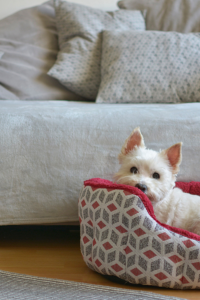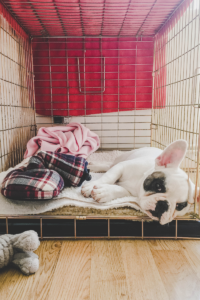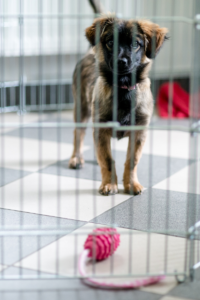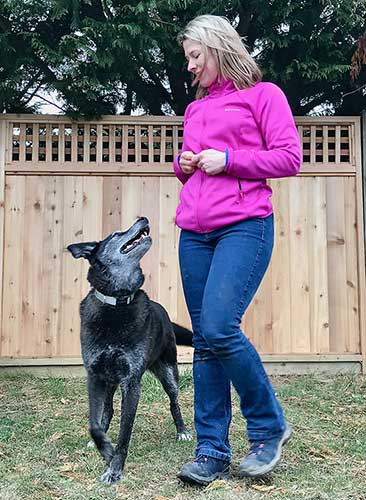
Contain your dog in the car.
One of the kindest and most important things a pet parent can do is establish limits for a new dog from the moment he/she comes home.
If you don’t want your adult dog to sleep on your bed, climb up on furniture, jump up on guests, or run up to strangers when out and about, don’t let your puppy/new rescue develop these habits to start with. It’s much easier to prevent a dog from learning unwanted behaviors than it is to try to change them after they’ve been rehearsing them for weeks/months/years. Oh, and it will help with potty training too (read on to learn how).

If you don’t want your dog on the furniture, train him to love his comfy bed.
Establish boundaries/limits
Young puppies and new dogs do not need the run of the house. Neither do they need uninterrupted access to you at all times. Too much freedom only allows unwanted habits to develop. Too much time with you makes being alone that much harder.
Movement stimulates the digestive system – more movement means more potty breaks will be needed. A crate/small confinement area helps with potty training as it prevents a dog from moving around too much – it helps them to learn how to “hold it”. (A dog can “hold it” overnight when they’re asleep but if they’re awake and moving around they will need to go to the bathroom.)
It’s also really helpful for training purposes to make yourself more relevant. If pup can access what he wants whenever he wants, he’s not going to need you for much which is a shame because, by controlling resources, you can more easily control the dog.
Active supervision or containment

Keep your puppy safe by crate or confinement training.
Very young puppies need to be under constant supervision or contained. Think kids and swimming pools – if you’re not watching them they shouldn’t be in the water.
Adolescent dogs will find things to entertain themselves if left to their own devices. Whether they are left alone inside or outside, what they consider “fun” is unlikely to be a behavior you want to encourage.
Let’s look at an example. You’re working from home. Pup is near you but not contained. Your boss calls. When your call finishes you look around for pup but he’s no longer near you. As you start looking for him you discover that he has peed on the hallway carpet, chewed apart your brand-new shoes, and pulled the (potentially poisonous) potted plant over. By following the muddy footprints you are able to find him in the kitchen where he has knocked over the trash and is just about to eat the carcass of last night’s roast chicken. Phew, emergency visits to the vet were averted (this time) but all of this could have been easily prevented by having pup contained or with you in the work area to start with.
How to contain/limit your dog
A crate and/or “Ex-Pen” is your best friend when bringing a new puppy home. It doesn’t need to take a lot of time to get young puppies comfortable in their crate (and good breeders will already have done this for you) but there is a process (see handout “Creating the Great Crate”. If your dog is going to travel with you or when he inevitably spends time at a vet he is going to be in a crate so getting him used to one is both useful and kind.
Ex-pens provide larger containment areas while you crate train but can also be used to cordon off areas in the house. A kitchen that can be shut off from the rest of the house, a mud room, or a laundry room can all be great “areas” in which to limit a pup if the crate isn’t an option. If the crate or confinement area is impossible, you can tether the dog to your body by hooking the leash around your belt or at least to something sturdy close by. (Never leave a dog unattended if tethered – he can get caught up/hurt/strangled.)
Helpful hints
As with learning to love the crate itself, there are some quick tricks to help pup be comfortable alone/separated from you in his containment area. First, make sure pup has had a chance to empty his bladder and bowel. Has he had sufficient physical exercise? Have you done some training?

Leave your dog with a few toys in his confinement area.
Leaving pup with something to do in his containment area will make this process easier – how about a stuffed (and ideally frozen) Kong or marrow bone? A really long-lasting chew? Licky mats smeared (and perhaps frozen) with some yummy soft food. Think of calming activities that your dog can do safely by himself rather than noisy games that will only increase his arousal.
Don’t make the containment area so big that pup has lots of room to move around and get “worked up”. Ideally, the space is small enough that there’s only really room for a comfy bed, a few calming toys, and perhaps a water bowl and place to eliminate if you have to leave him for an extended period.
For some dogs, the crate will need to be nearby so pup can see you. For other dogs though a containment area further away means that you’re not a distraction and you won’t accidentally respond to attention-seeking behaviors like barking/pawing. Consider covering a crate to create a den-like structure. Play some soothing background music, leave on the tv or talk radio, or maybe think about a grey noise machine. You’re going to have to see what set-up works best for your dog. If your dog is nearby, you have the benefit of occasionally (and calmly) rewarding him for being quiet. Some dogs on the other hand need a quiet place away from the household bustle in order to truly relax.
Summary
If you aren’t actually supervising your new dog, he is going to explore, wander, investigate things with his mouth (ie: chew) or very likely have a potty accident. If you’re not there to supervise pup (ie: give him your undivided attention) then containment in a puppy-safe area prevents him from getting into trouble. You’re also preventing pup from becoming an entitled dog that believes he can do anything and everything that he wants. Perhaps the most important consequence is that pup also starts learning to spend time by himself and that you’re not there solely to entertain him/her.
Establishing limits from the get-go is one of the easiest steps you can take to raise the dog of your dreams.


